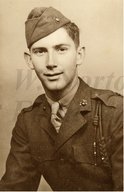
|

|
|
|
|
He was born in Saratoga, Texas, to B.F. Schilling and Bertha Morris Schilling. His parents separated when he was a small boy. Ira moved with his mother to the Cedar Grove neighborhood of Shreveport, where she worked for a meat packing company. He held several jobs while attending Byrd High School, including delivering newspapers and working in a drugstore. He left high school early to enlist in October of 1941. "I just wanted to be a Marine," he recalls. He was slim, weighing only 130 pounds, and stood five feet, eleven and a half inches when he went to boot camp in San Diego. Graduating on December 5, 1941, he was ready to depart on a ten-day pass when news of Pearl Harbor arrived. The base was immediately closed. Ira was placed in a casual battalion, and was tasked with digging foxholes along the bay as a precaution to a possible Japanese attack. He was soon transferred to Company L, Sixth Regiment, Second Marine Division, and was sent into infantry training at Camp Elliott near San Diego. He sailed for Wellington, New Zealand in late summer of 1942, took additional training, and then entered the fighting on Guadalcanal. "It was really terrible, really," he says of combat on the island. Returning to Wellington after Guadalcanal was secured he remained there for a few months in the summer of 1943. There he contracted malaria. In November, 1943, armed with the new M-1 rifle, he fought at Tarawa, landing on the second day of action. After Tarawa his unit returned to Hawaii, where Ira trained with the new flamethrower. The next campaign came in June of 1944 when his division fought at Saipan. Ira wore a demolition pack and carried a flamethrower, a unit that weighed 80 pounds. With the flamethrower, he says, he was a marked man. "Whenever they spotted you with a flamethrower on your back, they threw everything," he says of the Japanese. "Only three, maybe four" members of his squad survived a month of fighting on Saipan, he recalls. He next landed at Tinian and fought until Americans controlled the island. Ira was sent home in the fall of 1944, having earned enough points. He was also extremely ill with malaria. After convalescence in San Diego, he was sent to a naval base in Norfolk, Virginia, where he was assigned guard duty. He was at Camp Lejeune in North Carolina, where, he says, "there were about to retrain us and send us back." The war ended while he was stationed there. For all his combat in the war, Ira did not earn a Purple Heart. He received only a "scrape" from a machine gun on the skin of the knee cap. Discharged from Lejeune in October of 1945, he returned to Shreveport where he worked as a cable splicer for AT&T, as a milk deliverer for Jersey Gold Creamery, as a drugstore clerk, and finally as a postal clerk. He wanted to return to the Marines, but enlistments were frozen. Instead, he served in the Marine reserves. Ira joined the U.S. Navy, served a tour of duty, then worked at a lumber mill in Oregon. He returned to Shreveport and Bossier City and went back to the post office, where he retired in "1979 or 1980." Ira was converted at a church in Cedar Grove in 1953. Wanting to enter the ministry, he earned his GED at Centenary College, then eventually earned a master's degree in theology. Working full-time at the post office, he also served as minister at small Southern Methodist churches. He married Ruth Girlinghouse on January 3, 1954. They have three children (one each by previous marriages and one together), three grandchildren and one great-grandchild. |


